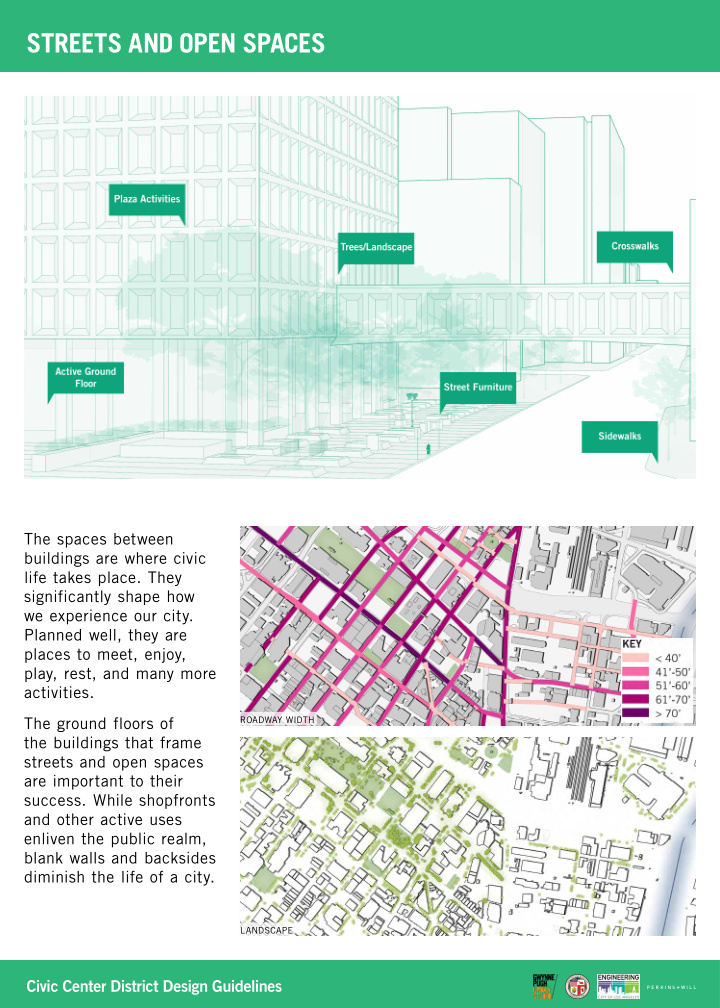



STREETS AND OPEN SPACES The spaces between buildings are where civic life takes place. They significantly shape how we experience our city. Planned well, they are places to meet, enjoy, play, rest, and many more activities. The ground floors of ROADWAY WIDTH the buildings that frame streets and open spaces are important to their success. While shopfronts and other active uses enliven the public realm, blank walls and backsides diminish the life of a city. LANDSCAPE Civic Center District Design Guidelines
Precedent Images GROUND-FLOOR ACTIVATION PARKS PASEOS STREETS SIDEWALKS TEXT
BUILDINGS AND ARCHITECTURE Buildings house the many different uses that make a vibrant neighborhood. They also shape the neighborhood with their presence in the public realm. Well-designed architecture that respects the human scape makes a neighborhood fell FIGURE GROUND BUILDING FOOTPRINT SIZE welcoming. They can provide a sense of safety day and night. In Civic Center, new buildings should enhance the appearance of City Hall and not overshadow it. BUILDING ENTRANCES Civic Center District Design Guidelines
Precedent Images FABRIC VS. ICON RELATIONSHIP TO CITY HALL BULK AND HEIGHT FACADES MASSING
IDENTITY AND WAYFINDING Great neighborhoods have an identity of their own. When you get there, you know that you have arrived. Many things come together to create this identity: the character of buildings, materials, plants and trees, the uses, the presence of art, and many more. DISTRICTS DISTRICT LOT COVERAGE The future Civic Center should reflect the Los Angeles we love. It should also have an identity of its own that reflects its role as the center of government for all Angelenos. In addition, it should be easy to find your destination. CIVIC CENTER INTERSECTIONS FRONTAGE | MAIN & FIRST Civic Center District Design Guidelines
Precedent Images WAYFINDING ACCESSIBILITY ART IDENTITY SKYLINE
MOBILITY AND TECHNOLOGY Today, the way we con- nect with the city is chang- ing rapidly. There are more and more choices about how to get around. Bike shares, scooters, hoverboards, and others augment cars, bikes, and transit. At the same time, the internet allows us to do business at City Hall METRO TRANSIT without even going there. Civic Center will accommo- date not only today’s technol- ogies but also tomorrow’s. How we build neighborhoods also influences our environ- mental footprint. New devel- opment in Civic Center will consider our use of water, energy, and other resources. SURFACE PARKING LOTS Civic Center District Design Guidelines
Precedent Images DIGITAL INFORMATION SUSTAINABILITY ACCESS VIA DEVICES MULTI-MODALITY
Streets and Open Spaces t e e r t S • e e u p n o e • H v A e • d n a r • G Union Station • 101 FWY Union Station • Walt Disney Concert Hall Civic Center / Grand Park Station Buildings and Architecture • Grand Park Temple Street • City Hall • • t e • e r t S • a d t e e 1st Street e m Parker LAPD r t a S Center l Identity and Wayfinding A o s i A Spring Street Caltrans • n h o J 2 • n e d Japanese g d S t u r American • e J e Main Street t National • Little Tokyo/Arts District Station Museum Los Angeles Street • • 3 San Pedro Street r d S t r e e t Mobility and Technology Japanese American Cultural • & Community Center • • • • • Civic Center District Design Guidelines
Recommend
More recommend